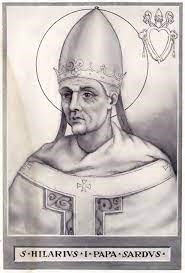
St Hilarion
Pope Saint Hilarus
[Also spelled HILARIUS]
Elected 461; the date of his death is given as 28 Feb., 468. After the death of Leo I, an archdeacon named Hilarus, a native of Sardinia, according to the “Liber Pontificalis”, was chosen to succeed him, and in all probability received consecration on 19 November, 461. Together with Julius, Bishop of Puteoli, Hilarus acted as legate of Leo I at the “Robber Synod” of Ephesus in 449. There he fought vigorously for the rights of the Roman See and opposed the condemnation of Flavian of Constantinople (see SAINT FLAVIAN). He was therefore exposed to the violence of Dioscurus of Alexandria, and saved himself by flight. In one of his letters to the Empress Pulcheria, found in a collection of letters of Leo I (“Leonis I Epistolae”, num. xlvi., in P.L., LIV, 837 sq.), Hilarus apologizes for not delivering to her the pope’s letter after the synod; but owing to Dioscurus, who tried to hinder his going either to Rome or to Constantinople, he had great difficulty in making his escape in order to bring to the pontiff the news of the result of the council. His pontificate was marked by the same vigorous policy as that of his great predecessor. Church affairs in Gaul and Spain claimed his special attention. Owing to political disorganization in both countries, it was important to safeguard the hierarchy by strengthening church government. Hermes, a former archdeacon of Narbonne, had illegally acquired the bishopric of that town. Two Gallican prelates were dispatched to Rome to lay before the pope this and other matters concerning the Church in Gaul. A Roman synod held on 19 November, 462, passed judgment upon these matters, and Hilarus made known the following decisions in an Encyclical sent to the provincial bishops of Vienne, Lyons, Narbonne, and the Alps: Hermes was to remain Titular Bishop of Narbonne, but his episcopal faculties were withheld. A synod was to be convened yearly by the Bishop of Arles, for those of the provincial bishops who were able to attend; but all important matters were to be submitted to the Apostolic See. No bishop could leave his diocese without a written permission from the metropolitan; in case such permission be withheld he could appeal to the Bishop of Arles. Respecting the parishes (paroeciae) claimed by Leontius of Arles as belonging to his jurisdiction, the Gallican bishops could decide, after an investigation. Church property could not be alienated until a synod had examined into the cause of sale.
Shortly after this the pope found himself involved in another diocesan quarrel. In 463 Mamertus of Vienne had consecrated a Bishop of Die, although this Church, by a decree of Leo I, belonged to the metropolitan Diocese of Arles. When Hilarus heard of it he deputed Leontius of Arles to summon a great synod of the bishops of several provinces to investigate the matter. The synod took place and, on the strength of the report given him by Bishop Antonius, he issued an edict dated 25 February, 464, in which Bishop Veranus was commissioned to warn Mamertus that, if in the future he did not refrain from irregular ordinations, his faculties would be withdrawn. Consequently the consecration of the Bishop of Die must be sanctioned by Leontius of Arles. Thus the primatial privileges of the See of Arles were upheld as Leo I had defined them. At the same time the bishops were admonished not to overstep their boundaries, and to assemble in a yearly synod presided over by the Bishop of Arles. The metropolitan rights of the See of Embrun also over the dioceses of the Maritime Alps were protected against the encroachments of a certain Bishop Auxanius, particularly in connection with the two Churches of Nice and Cimiez.
In Spain, Silvanus, Bishop of Calahorra, had, by his episcopal ordinations, violated the church laws. Both the Metropolitan Ascanius and the bishops of the Province of Tarragona made complaint of this to the pope and asked for his decision. Before an answer came to their petition, the same bishops had recourse to the Holy See for an entirely different matter. Before his death Nundinarius, Bishop of Barcelona, expressed a wish that Irenaeus might be chosen his successor, although he had himself made Irenaeus bishop of another see. The request was granted, a Synod of Tarragona confirming the nomination of Irenaeus, after which the bishops sought the pope’s approval. The Roman synod of 19 Nov., 465, took the matters up and settled them. This is the oldest Roman synod whose original records have been handed down to us. It was held in the basilica of Santa Maria Maggiore. After an address of the pope, and the reading of the Spanish letters, the synod decided that the church laws must not be tampered with. In addition to this Hilarus sent a letter to the bishops of Tarragona, declaring that no consecration was valid without the sanction of the Metropolitan Ascanius; and no bishop was permitted to be transferred from one diocese to another, so that some one else must be chosen for Barcelona in place of Irenaeus. The bishops consecrated by Silvanus would be recognized if they had been appointed to vacant sees, and otherwise met the requirements of the Church. The “Liber Pontificalis” mentions an Encyclical that Hilarus sent to the East, to confirm the Oecumenical Councils of Nicaea, Ephesus, and Chalcedon, and the dogmatic letter of Leo I to Flavian, but the sources at our disposal furnish us no further information. In Rome Hilarus worked zealously for the integrity of the Faith. The Emperor Anthemius had a favourite named Philotheus, who was a believer in the Macedonian heresy and attended meetings in Rome for the promulgation of this doctrine, 476. On one of the emperor’s visits to St. Peter’s, the pope openly called him to account for his favourite’s conduct, exhorting him by the grave of St. Peter to promise that he would do all in his power to check the evil. Hilarus erected several churches and other buildings in Rome. Two oratories in the baptistery of the Lateran, one in honour of St. John the Baptist, the other of St. John the Apostle, are due to him. After his flight from the “Robber Synod” of Ephesus, Hilarus had hidden himself in the crypt of St. John the Apostle, and he attributed his deliverance to the intercession of the Apostle. Over the ancient doors of the oratory this inscription is still to be seen: “To St. John the Evangelist, the liberator of Bishop Hilarus, a Servant of Christ”. He also erected a chapel of the Holy Cross in the baptistery, a convent, two public baths, and libraries near the Church of St. Laurence Outside the Walls. He built another convent within the city walls. The “Liber Pontificalis” mentions many votive offerings made by Hilarus in the different churches. He died after a pontificate of six years, three months, and ten days. He was buried in the church of St. Laurence Outside the Walls. His feast day is celebrated on 17 November.
Sources
Epistolae Romanorum Pontificum, ed. THIEL, I (Braunsberg, 1868), 126-74; JAFFE, Regesta Rom. Pont., I (2nd ed., Leipzig, 1885), 75-77; Liber Pontificalis, ed. DUCHESNE, I, 242 sqq.; ed. MOMMSEN, I, 107 sqq.; HEFELE, Conciliengeschichte, 2nd ed., II, passim; GRISAR, Geschichte Roms und der Papste im Mittelalter, I (Freiburg im Br., 1901), passim; LANGEN, Geschichte der römischen Kirche, II (Bonn, 1885), 113 sqq.
APA citation. Kirsch, J.P. (1910). Pope Saint Hilarus. In The Catholic Encyclopedia. New York: Robert Appleton Company. Retrieved October 18, 2022 from New Advent: http://www.newadvent.org/cathen/07348b.htm

